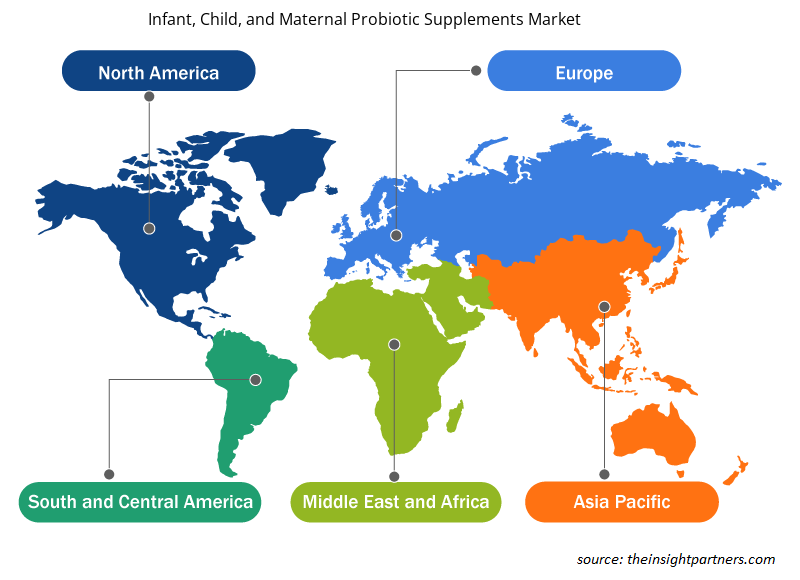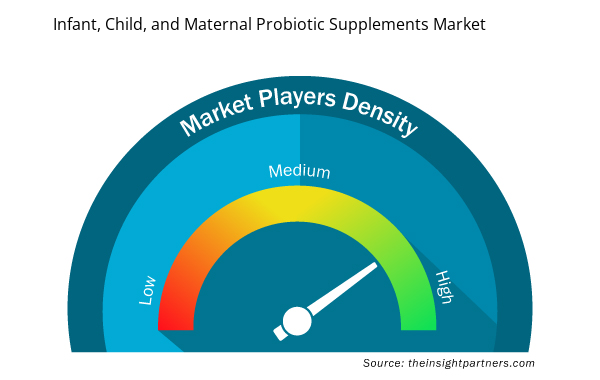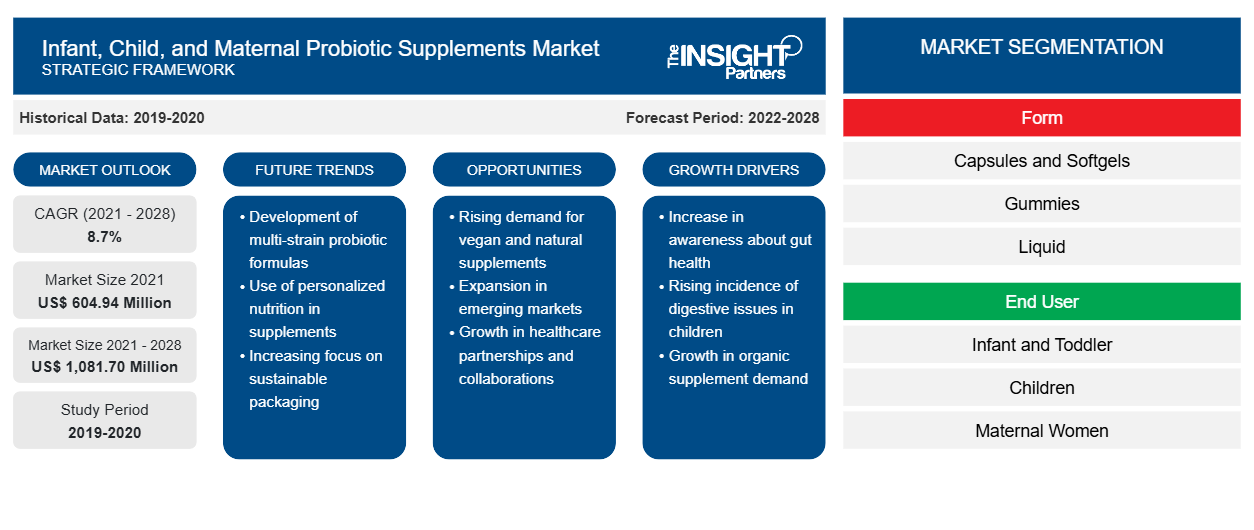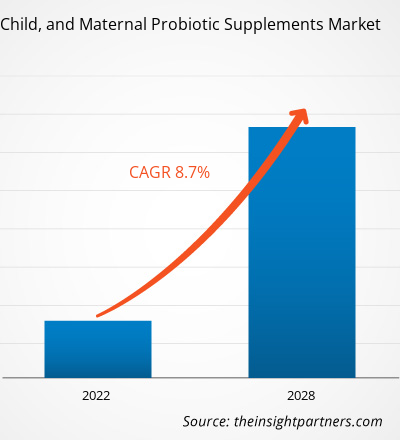Le marché des suppléments probiotiques pour nourrissons, enfants et mères devrait atteindre 1 081,70 millions USD d'ici 2028, contre 604,94 millions USD en 2021. Il devrait croître à un TCAC de 8,7 % de 2022 à 2028.probiotic supplements market is projected to reach US$ 1,081.70 million by 2028 from US$ 604.94 million in 2021. It is expected to grow at a CAGR of 8.7% from 2022 to 2028.
Les probiotiques sont des bactéries et/ou des levures vivantes qui sont bénéfiques pour la santé intestinale. Les suppléments probiotiques présentent de nombreux avantages , notamment la stimulation du microbiome intestinal, le rétablissement de l'équilibre du microbiome et le soutien du système immunitaire. Ces avantages ont fait augmenter son utilisation auprès du public cible, qui comprend les nourrissons, les enfants et les femmes enceintes. Les parents se concentrent de plus en plus sur la nutrition et le bien-être de leur enfant, ce qui stimule le marché. De plus, l'adoption croissante des suppléments probiotiques par les femmes enceintes a considérablement stimulé le marché. La recherche et le développement constants dans cette catégorie à travers le monde stimuleront la croissance du marché dans les années à venir
En 2020, l'Amérique du Nord détenait la plus grande part du marché mondial des suppléments probiotiques pour nourrissons, enfants et mères , et l'Asie-Pacifique devrait enregistrer le TCAC le plus rapide au cours de la période de prévision. L'augmentation de la population, le développement économique et l'augmentation du revenu disponible sont quelques-uns des facteurs contribuant à la croissance du marché. La population des économies émergentes, comme l'Inde, la Chine et le Japon, adopte des compléments nutritionnels pour améliorer la croissance et le développement des enfants. De plus, l'augmentation du taux de mortalité infantile dans les économies émergentes a alimenté la demande de suppléments probiotiques dans la région. Par exemple, selon la Banque mondiale, en 2020, le taux de mortalité infantile en Asie de l'Est-Pacifique était de 11 pour 1 000 naissances vivantes.
Personnalisez ce rapport en fonction de vos besoins
Vous bénéficierez d'une personnalisation gratuite de n'importe quel rapport, y compris de certaines parties de ce rapport, d'une analyse au niveau des pays, d'un pack de données Excel, ainsi que de superbes offres et réductions pour les start-ups et les universités.
- Obtenez les principales tendances clés du marché de ce rapport.Cet échantillon GRATUIT comprendra une analyse de données, allant des tendances du marché aux estimations et prévisions.
Impact de la pandémie de COVID-19 sur le marché des suppléments probiotiques pour nourrissons, enfants et mères
Avant le début de la pandémie de COVID-19, le marché des compléments probiotiques pour nourrissons, enfants et mères était principalement stimulé par l'intérêt croissant des parents pour une nutrition infantile spécifique et la demande croissante de compléments nutritionnels adaptés aux besoins des femmes enceintes. Cependant, le marché a été confronté à des défis sans précédent après l'épidémie de 2020. Les fabricants de compléments probiotiques pour nourrissons, enfants et mères ont été confrontés à des défis importants en raison des contraintes de la chaîne d'approvisionnement causées par les confinements nationaux, les interdictions commerciales et les restrictions de voyage. Les perturbations de la chaîne d'approvisionnement ont créé une pénurie de matières premières, ce qui a affecté la production et la distribution de divers produits, entraînant une augmentation des prix.probiotic supplements market was mainly driven by the rising focus of parents on specific infant nutrition and the increasing demand for nutritional supplements tailored according to the needs of pregnant women. However, the market faced unprecedented challenges after the outbreak in 2020. Manufacturers of infant, child, and maternal probiotic supplements faced significant challenges due to supply chain constraints caused by nationwide lockdowns, trade bans, and travel restrictions. Supply chain disruptions created a shortage of raw materials, which affected the production and distribution of various products, leading to increased prices.
En 2021, plusieurs économies ont repris leurs activités, les gouvernements ayant annoncé un assouplissement des restrictions imposées précédemment, ce qui a stimulé le marché mondial. En outre, les installations de production ont été autorisées à fonctionner à pleine capacité, ce qui les a aidées à surmonter l'écart entre l'offre et la demande et d'autres répercussions. Comme de nombreux citoyens de nombreux pays ont été entièrement vaccinés en 2021, les acteurs du marché se sont concentrés sur l'augmentation de leur production pour relancer leurs activités.
Informations sur le marché
La prise de conscience croissante des bienfaits des suppléments probiotiques chez les femmes enceintes devrait stimuler le marché des suppléments probiotiques pour les nourrissons, les enfants et les mèresProbiotic Supplements among Pregnant Women to Drive Infant, Child, and Maternal Probiotic Supplements Market
Les probiotiques réduisent le risque de prééclampsie chez les femmes enceintes, un problème de santé entraînant une hypertension artérielle et des taux élevés de protéines dans les urines. Les suppléments probiotiques assurent également une meilleure immunité aux femmes enceintes, ce qui permet de lutter contre les maladies chroniques et d'assurer la bonne santé du bébé. Lactobacillus acidophilus, Bifidobacterium bifidum et Saccharomyces boulardii font partie des souches probiotiques les plus efficaces et les plus utilisées dans les suppléments probiotiques prénatals. Ces souches aident à maintenir une flore intestinale saine et à réduire le risque de diverses allergies, maladies et complications, notamment le diabète gestationnel et la prééclampsie. La prise de conscience croissante des bienfaits des suppléments probiotiques chez les femmes enceintes stimule considérablement le marché des suppléments probiotiques pour les nourrissons, les enfants et les mères. lower the risk of pre-eclampsia in pregnant women, a health condition resulting in high blood pressure and high protein levels in urine. Probiotic supplements also ensure better immunity for pregnant women, which helps fight chronic diseases and ensure the baby's good health. Lactobacillus acidophilus, Bifidobacterium bifidum, and Saccharomyces boulardii are among the most effective and widely used probiotic strains in prenatal probiotic supplements. These strains help to maintain a healthy intestinal flora and reduce the risk of various allergies, diseases, and complications, including gestational diabetes and pre-eclampsia. The growing awareness about the benefits of probiotic supplements among pregnant women is substantially driving the infant, child, and maternal probiotic supplements market.
Informations sur les formulaires
En fonction de la forme, le marché des suppléments probiotiques pour nourrissons, enfants et mères est classé en capsules et gélules, gummies, liquides et autres. Les autres segments détenaient la plus grande part du marché au cours de la période de prévision. Cependant, le segment des gummies devrait enregistrer le TCAC le plus élevé au cours de la période de prévision. Les gummies probiotiques sucrés et faciles à consommer sont disponibles dans des couleurs et des formes attrayantes (comme des ours en peluche) et diverses saveurs. Plusieurs fabricants sont engagés dans des innovations de produits pour répondre aux demandes croissantes des adultes et des enfants. De tels développements stratégiques des fabricants pour diversifier leur gamme de produits sont susceptibles de propulser la demande de gummies de suppléments probiotiques pour nourrissons, enfants et mères dans les années à venir.
Informations sur l'utilisateur final
En fonction de l'utilisateur final, le marché des suppléments probiotiques pour nourrissons, enfants et mères est segmenté en nourrissons et tout-petits, enfants et femmes mères. Le segment des enfants représentait la plus grande part de marché en 2020. Les suppléments probiotiques gagnent en popularité chez ces enfants car ils jouent un rôle essentiel dans le soulagement des coliques, de la constipation aiguë et du reflux acide. Certains chercheurs ont montré que les probiotiques peuvent aider à prévenir la diarrhée liée aux antibiotiques chez les enfants, c'est pourquoi les pédiatres incluent souvent des suppléments probiotiques lors de la prescription d'antibiotiques.probiotic supplements market is segmented into infants and toddlers, children, and maternal women. The children segment accounted for the largest market share in 2020. Probiotic supplements are gaining popularity in these children as they play a vital role in relieving colic, acute constipation, and acid reflux. Some researchers have shown that probiotics can help prevent antibiotic-related diarrhea in children, so pediatricians often include probiotic supplements while prescribing antibiotics.
Les principaux acteurs opérant sur le marché des compléments probiotiques pour nourrissons, enfants et mères sont Bayer Corporation ; Nestlé SA ; Mommy's Bliss Inc. ; LoveBug Probiotics ; BioGaia AB ; MaryRuth Organics, LLC ; Pharmavite LLC ; Evolve Biosystems ; Biomeology ; et Nordic Naturals. Ces entreprises mettent l'accent sur le lancement de nouveaux produits et l'expansion géographique pour répondre à la demande croissante des consommateurs dans le monde entier. Elles ont une présence mondiale étendue, ce qui leur permet de servir un large éventail de clients du monde entier et d'augmenter par la suite leur part de marché. Ces acteurs du marché se concentrent fortement sur le lancement de nouveaux produits et l'expansion régionale pour élargir leur gamme de produits dans des portefeuilles spécialisés.probiotic supplements market include Bayer Corporation; Nestle S.A.; Mommy’s Bliss Inc.; LoveBug Probiotics; BioGaia AB; MaryRuth Organics, LLC; Pharmavite LLC; Evolve Biosystems; Biomeology; and Nordic Naturals. These companies are emphasizing on new product launches and geographical expansions to meet the growing consumer demand worldwide. They have a widespread global presence, which provides them to serve a large set of customers from all over the world and subsequently increases their market share. These market players focus heavily on new product launches and regional expansions to increase their product range in specialty portfolios.
Aperçu régional du marché des suppléments probiotiques pour nourrissons, enfants et mères
Les tendances et facteurs régionaux influençant le marché des suppléments probiotiques pour nourrissons, enfants et mères tout au long de la période de prévision ont été expliqués en détail par les analystes d’Insight Partners. Cette section traite également des segments et de la géographie du marché des suppléments probiotiques pour nourrissons, enfants et mères en Amérique du Nord, en Europe, en Asie-Pacifique, au Moyen-Orient et en Afrique, ainsi qu’en Amérique du Sud et en Amérique centrale.

- Obtenez les données régionales spécifiques au marché des suppléments probiotiques pour nourrissons, enfants et mères
Portée du rapport sur le marché des suppléments probiotiques pour nourrissons, enfants et mères
| Attribut de rapport | Détails |
|---|---|
| Taille du marché en 2021 | 604,94 millions de dollars américains |
| Taille du marché d'ici 2028 | 1 081,70 millions de dollars américains |
| Taux de croissance annuel moyen mondial (2021-2028) | 8,7% |
| Données historiques | 2019-2020 |
| Période de prévision | 2022-2028 |
| Segments couverts | Par formulaire
|
| Régions et pays couverts | Amérique du Nord
|
| Leaders du marché et profils d'entreprises clés |
|
Densité des acteurs du marché des suppléments probiotiques pour nourrissons, enfants et mères : comprendre son impact sur la dynamique commerciale
Le marché des suppléments probiotiques pour nourrissons, enfants et mères connaît une croissance rapide, tirée par la demande croissante des utilisateurs finaux en raison de facteurs tels que l'évolution des préférences des consommateurs, les avancées technologiques et une plus grande sensibilisation aux avantages du produit. À mesure que la demande augmente, les entreprises élargissent leurs offres, innovent pour répondre aux besoins des consommateurs et capitalisent sur les tendances émergentes, ce qui alimente davantage la croissance du marché.
La densité des acteurs du marché fait référence à la répartition des entreprises ou des sociétés opérant sur un marché ou un secteur particulier. Elle indique le nombre de concurrents (acteurs du marché) présents sur un marché donné par rapport à sa taille ou à sa valeur marchande totale.
Les principales entreprises opérant sur le marché des suppléments probiotiques pour nourrissons, enfants et mères sont :
- Société Bayer
- Nestlé SA
- Maman
Avis de non-responsabilité : les sociétés répertoriées ci-dessus ne sont pas classées dans un ordre particulier.

- Obtenez un aperçu des principaux acteurs clés du marché des suppléments probiotiques pour nourrissons, enfants et mères
Rapports en vedette
- Tendances progressistes de l'industrie sur le marché des suppléments probiotiques pour nourrissons, enfants et mères pour aider les entreprises à développer des stratégies efficaces à long terme
- Stratégies de croissance commerciale adoptées par les acteurs du marché des suppléments probiotiques pour nourrissons, enfants et mères dans les pays développés et en développement
- Analyse quantitative du marché de 2020 à 2028
- Estimation de la demande mondiale de vêtements de travail
- Analyse des cinq forces de Porter pour illustrer l'efficacité des acheteurs et des fournisseurs sur le marché des suppléments probiotiques pour nourrissons, enfants et mères
- Développements récents pour comprendre le scénario concurrentiel du marché
- Tendances et perspectives du marché, ainsi que facteurs qui stimulent et freinent la croissance du marché des suppléments probiotiques pour nourrissons, enfants et mères
- Aide à la prise de décision en mettant en évidence les stratégies de marché qui sous-tendent l'intérêt commercial
- Taille du marché des suppléments probiotiques pour nourrissons, enfants et mères à différents niveaux
- Un aperçu détaillé et la dynamique de l'industrie des vêtements de travail
- Taille du marché des suppléments probiotiques pour nourrissons, enfants et mères dans diverses régions avec des opportunités de croissance prometteuses
- Analyse historique (2 ans), année de base, prévision (7 ans) avec TCAC
- Analyse PEST et SWO
- Taille du marché Valeur / Volume - Mondial, Régional, Pays
- Industrie et paysage concurrentiel
- Ensemble de données Excel



Report Coverage
Revenue forecast, Company Analysis, Industry landscape, Growth factors, and Trends

Segment Covered
This text is related
to segments covered.

Regional Scope
North America, Europe, Asia Pacific, Middle East & Africa, South & Central America

Country Scope
This text is related
to country scope.
Questions fréquemment posées
Of late, parents have become more concerned about specific nutrition for their children to ensure proper growth and development. According to the World Health Organization (WHO), providing proper nutrition to babies in their first 3 years can reduce mortality and morbidity in them, decrease the risk of chronic diseases throughout their lifetime, and promote regular mental and physical growth. The poor nutrition of infants can cause serious health issues, including stunted growth and malnutrition. Additionally, poor nutrition during the first 3 months of a baby's life can increase the risk of death. However, the rise in awareness regarding proper infant nutrition among parents has reduced the infant mortality rate. Therefore, increase in awareness regarding such nutritional intake has surged the demand for infant, child, and maternal probiotic supplements market.
Based on the end user, maternal women segment is projected to grow at the fastest CAGR over the forecast period. Probiotic supplements are gaining popularity among pregnant women owing to their role in reducing the risk of eczema in babies, lessening complications associated with childbirth, and improving the metabolic health of expectant mothers. Women experience dramatic changes in physiology and immune systems during pregnancy, including alterations in the gut microbiome population. These issues can be addressed using probiotic supplements. Probiotic supplements help pregnant women in gaining weight.
North America accounted for the largest share of the global workwear market. North America is one of the most significant regions for the infant, child, and maternal probiotic supplements market due to the increasing awareness about the benefits offered by probiotic supplements in infants, children, and pregnant women. Parents in the region are more concerned about their children's development and growth. Some common health conditions observed in the region include allergies, asthma, urinary tract infection, colic in infants, and autism. According to the Allergy & Asthma Foundation of Asthma, in 2018, approximately 5.2 thousand children in the US were diagnosed with seasonal allergic rhinitis. Increasing health issues among children have concerned parents, which in turn, has resulted in the uptake of probiotic supplements.
Based on form, others segment mainly has the largest revenue share. The other forms in the segment include powder, tablets, chewable tablets, effervescent tablets, lozenges, and quick dissolvable formats. The growth is attributed by increasing use of these forms owing to their various benefits such as longer shelf life and physiochemical stability of powder, inexpensive, more effective, and among others. Moreover, such benefits offered by this form have surged manufacturers to in launching probiotic supplements in various forms such as lozenges.
The major players operating in the global infant, child, and maternal probiotic supplements market are Bayer Corporation; Nestle S.A.; Mommy’s Bliss Inc.; LoveBug Probiotics; Biogaia AB; MaryRuth Organics, LLC; Pharmavite LLC; Evolve Biosystems; Biomeology; and Nordic Naturals.
Infant nutrition is one of the most lucrative markets in Asia Pacific. The rising population, steady economic development, and increase in per capita income are some of the major factors driving the infant nutrition market. People in countries such as China, India, and South Korea are highly concerned about their children's health and wellbeing and are widely adopting dietary supplements that support their growth and development. Infant probiotic supplements are also gaining significant traction, owing to children and infants' rising focus on digestive health and immunity. Thus, the rising demand for infant probiotic supplements in developing markets is expected to provide lucrative growth opportunities over the forecast period.
Trends and growth analysis reports related to Consumer Goods : READ MORE..
The List of Companies - Infant, Child, and Maternal Probiotic Supplements Market
- Bayer Corporation
- Nestle S.A.
- Mommy’s Bliss Inc.
- LoveBug Probiotics
- Biogaia AB
- MaryRuth Organics, LLC
- Pharmavite LLC
- Evolve Biosystems
- Biomeology
- Nordic Naturals
The Insight Partners performs research in 4 major stages: Data Collection & Secondary Research, Primary Research, Data Analysis and Data Triangulation & Final Review.
- Data Collection and Secondary Research:
As a market research and consulting firm operating from a decade, we have published and advised several client across the globe. First step for any study will start with an assessment of currently available data and insights from existing reports. Further, historical and current market information is collected from Investor Presentations, Annual Reports, SEC Filings, etc., and other information related to company’s performance and market positioning are gathered from Paid Databases (Factiva, Hoovers, and Reuters) and various other publications available in public domain.
Several associations trade associates, technical forums, institutes, societies and organization are accessed to gain technical as well as market related insights through their publications such as research papers, blogs and press releases related to the studies are referred to get cues about the market. Further, white papers, journals, magazines, and other news articles published in last 3 years are scrutinized and analyzed to understand the current market trends.
- Primary Research:
The primarily interview analysis comprise of data obtained from industry participants interview and answers to survey questions gathered by in-house primary team.
For primary research, interviews are conducted with industry experts/CEOs/Marketing Managers/VPs/Subject Matter Experts from both demand and supply side to get a 360-degree view of the market. The primary team conducts several interviews based on the complexity of the markets to understand the various market trends and dynamics which makes research more credible and precise.
A typical research interview fulfils the following functions:
- Provides first-hand information on the market size, market trends, growth trends, competitive landscape, and outlook
- Validates and strengthens in-house secondary research findings
- Develops the analysis team’s expertise and market understanding
Primary research involves email interactions and telephone interviews for each market, category, segment, and sub-segment across geographies. The participants who typically take part in such a process include, but are not limited to:
- Industry participants: VPs, business development managers, market intelligence managers and national sales managers
- Outside experts: Valuation experts, research analysts and key opinion leaders specializing in the electronics and semiconductor industry.
Below is the breakup of our primary respondents by company, designation, and region:

Once we receive the confirmation from primary research sources or primary respondents, we finalize the base year market estimation and forecast the data as per the macroeconomic and microeconomic factors assessed during data collection.
- Data Analysis:
Once data is validated through both secondary as well as primary respondents, we finalize the market estimations by hypothesis formulation and factor analysis at regional and country level.
- Macro-Economic Factor Analysis:
We analyse macroeconomic indicators such the gross domestic product (GDP), increase in the demand for goods and services across industries, technological advancement, regional economic growth, governmental policies, the influence of COVID-19, PEST analysis, and other aspects. This analysis aids in setting benchmarks for various nations/regions and approximating market splits. Additionally, the general trend of the aforementioned components aid in determining the market's development possibilities.
- Country Level Data:
Various factors that are especially aligned to the country are taken into account to determine the market size for a certain area and country, including the presence of vendors, such as headquarters and offices, the country's GDP, demand patterns, and industry growth. To comprehend the market dynamics for the nation, a number of growth variables, inhibitors, application areas, and current market trends are researched. The aforementioned elements aid in determining the country's overall market's growth potential.
- Company Profile:
The “Table of Contents” is formulated by listing and analyzing more than 25 - 30 companies operating in the market ecosystem across geographies. However, we profile only 10 companies as a standard practice in our syndicate reports. These 10 companies comprise leading, emerging, and regional players. Nonetheless, our analysis is not restricted to the 10 listed companies, we also analyze other companies present in the market to develop a holistic view and understand the prevailing trends. The “Company Profiles” section in the report covers key facts, business description, products & services, financial information, SWOT analysis, and key developments. The financial information presented is extracted from the annual reports and official documents of the publicly listed companies. Upon collecting the information for the sections of respective companies, we verify them via various primary sources and then compile the data in respective company profiles. The company level information helps us in deriving the base number as well as in forecasting the market size.
- Developing Base Number:
Aggregation of sales statistics (2020-2022) and macro-economic factor, and other secondary and primary research insights are utilized to arrive at base number and related market shares for 2022. The data gaps are identified in this step and relevant market data is analyzed, collected from paid primary interviews or databases. On finalizing the base year market size, forecasts are developed on the basis of macro-economic, industry and market growth factors and company level analysis.
- Data Triangulation and Final Review:
The market findings and base year market size calculations are validated from supply as well as demand side. Demand side validations are based on macro-economic factor analysis and benchmarks for respective regions and countries. In case of supply side validations, revenues of major companies are estimated (in case not available) based on industry benchmark, approximate number of employees, product portfolio, and primary interviews revenues are gathered. Further revenue from target product/service segment is assessed to avoid overshooting of market statistics. In case of heavy deviations between supply and demand side values, all thes steps are repeated to achieve synchronization.
We follow an iterative model, wherein we share our research findings with Subject Matter Experts (SME’s) and Key Opinion Leaders (KOLs) until consensus view of the market is not formulated – this model negates any drastic deviation in the opinions of experts. Only validated and universally acceptable research findings are quoted in our reports.
We have important check points that we use to validate our research findings – which we call – data triangulation, where we validate the information, we generate from secondary sources with primary interviews and then we re-validate with our internal data bases and Subject matter experts. This comprehensive model enables us to deliver high quality, reliable data in shortest possible time.


 Obtenez un échantillon gratuit pour ce rapport
Obtenez un échantillon gratuit pour ce rapport